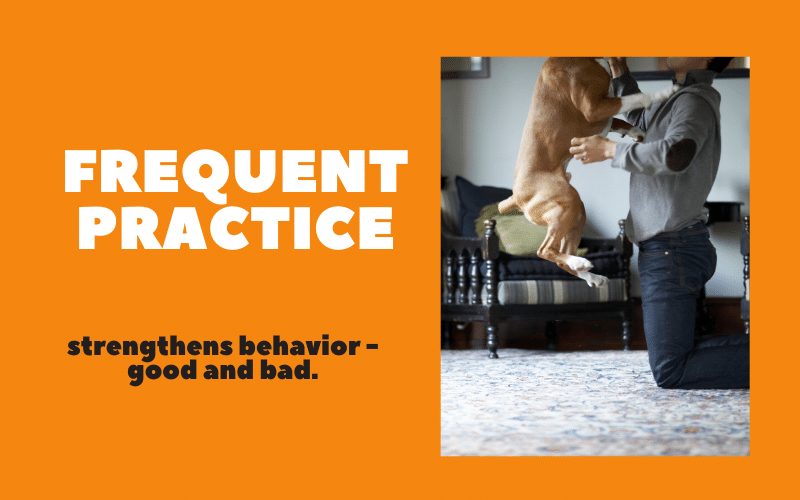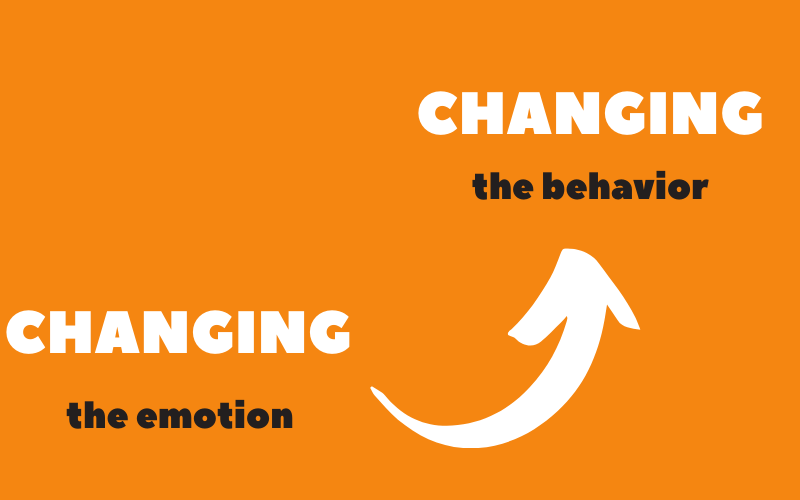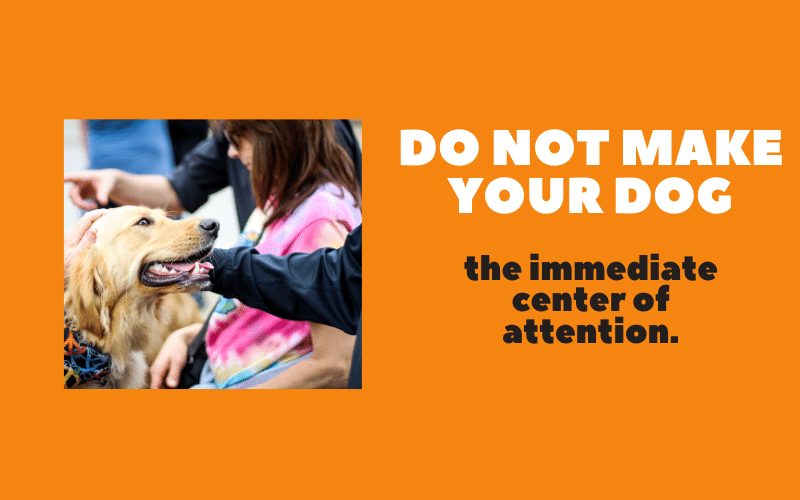How To Stop Your Dog From Jumping Up
May 27, 2021 2021-05-27 12:01Yes, they can learn to not do it
Let's Stop That Jumping

Whether puppy, adult dog or even senior canine – jumping up is a behavior seen across dogs of all breeds and dispositions. While a very natural behavior, jumping is often annoying, embarrassing (if it happens with strangers) or even dangerous (some dogs can easily push people – especially children – over).
The scenario in which jumping up happens will determine the training needed for fixing it. Let’s look at different cases of jumping and how they are best addressed. You can stop jumping! And we will help you do it.
Table of Contents
Not all jumping is the same
Jumping up when coming home
This is the “best rehearsed” type of jumping up. While other forms of jumping up – such as on visitors or people in public – only occur maybe once or twice a week, every family member will come home every day and offer an opportunity for this behavior to be practiced. Your dog very quickly builds up a habit of excited jumping and gets to ingrain it rapidly – because of the daily practice. Unfortunately, training always happens for dogs – not only when we decide it is formal training time, but every single time that behavior is rehearsed or your dog gets what he wants by performing a certain action.

Why do dogs jump on you when you get home?
When you get home after a long day at work (or even just a 30min trip to the store – for many dogs, there is no difference) your dog will be overjoyed to see you. He might want to lick your face, sniff you, and generally say “Welcome back!!” in the most excited way possible. And most of all he wants one thing: Attention and engagement.
This is where the self-enhancing nature of jumping up comes from: It is difficult to not engage with a dog that is jumping up in your face. On the other hand, it is easy to ignore a dog who has four paws on the floor or sits patiently. Some time in the past your dog might have learned that if he stands back, you will put away your groceries, check your emails, have a cup of coffee … but if he jumps up as high as possible, he will get some interaction for sure.

Why kneeing/scolding/pushing the dog away doesn’t work
You might have tried to counter your dog’s jumping by using your knees, hands and a stern voice to get him to stay down. For a small percentage of dogs this works – but it probably didn’t work for you, or you wouldn’t be reading this article now.
The reason these aversive methods don’t work is that the dog is in a very high state of drive when he greets you. The more excited he is, the harder it is to “bring the message across” with this approach. Your dog probably does not even feel reprimanded, he thinks you shoving him away is just a response to his greeting and might even interpret it as a game. This can even get to the point of you using more and more force (and/or yelling) to get your dog to stop as he gradually becomes more and more accustomed to the level of intensity.
Why asking your dog to sit doesn’t work
You probably have also tried to tell your dog to sit or lie down. Again – chances are he happily carried on with the jumping instead of doing as told. The reason your dog cannot respond to the cues in such a state of excitement is similar to the one above – once he is in such a high drive, it is very difficult for him to carry out behaviors you ask him for. He is simply too CrAzY for any kind of coordinated response.
This behavior occurs in humans as well by the way – we all have been so excited that we didn’t remember the answer to an easy question in an exam or tripped over our own words on a date.
Changing the emotion – changing the behavior
So – here is what actually will work.

Instead of having the dog predict an exciting, over-the-top welcome party – let’s associate a new emotion with you arriving at home. If your dog expects a calm, low-key encounter, he will not be in the mindset to jump . A dog that is relaxed and not excited is not a dog that jumps.
To promote the quiet state of mind, we will use sniffing, chewing or licking. These activities are very relaxing for your dog – they are basically an in-built calming system.
Before you leave, make some preparations for your return. You could fill a Kong and put it in your freezer, or fill a tupperware box with some treats stash it close to your front door. You can also use a lickmat, spread peanut butter on it and put it in the fridge.
When you get home, immediately give your dog his “calming item”. Go to your freezer/fridge and get out the lickmat or Kong, or take the treats from the tupperware box and scatter them for your dog (either inside or outside – whichever you prefer).
The first times your dog will probably still jump on you – that is ok. It takes a while to build up the new expectation and emotion that he connects to the situation.
The great thing however is that when we change the underlying emotion – from “oh YAY!” to “ah yes, my relaxing chewing time” – this will automatically change the outward representation of the subsequent behavior.
A dog that expects to lie down and chew will not be crazy and jumping everywhere.
Important: It will be crucial that you do not engage with your dog in an exciting way. Do not say “Hiiiii!” in a squeaky voice, do not give him attention in form of petting or smiling at hi, broadly. For a dog that is already very hyped up, these small gestures can be enough to push him over the top. In order to effectively stop jumping, you need to make sure that you train your dog to not expect an elaborate welcome back party.
Dog jumping up on visitors
Does your dog jump up on visitors?
The approach will be similar to the above. Always have a chew toy, lickmat or some treats for scattering ready. Ask your visitors to not engage with the dog – instead set him up with his calming activity (sniffing out scattered treats, or chewing/licking his toy) and do not make the welcome situation about the dog getting attention.
The same as above applies – if you teach your dog that the greeting will be low-key and non-exciting, his behavior will change.

Four paws on the floor
After your dog is finished with his treats or toy, he will probably come over to say hi to your visitors. Be prepared for this by handing them some treats and delivering them to the dog while he is in a standing position.
For a dog that is about as high as your knee, that means bending down and holding the treat right at his face level. A common mistake is the hold the treat high up to “keep it out of reach until the dog sits” – this unfortunately only encourages the dog to try to jump higher to get it!
If the treat is right at the dog’s face level, there will be no reason for him to jump – and over time this behavior will stop.
Dog jumping on strangers in public
Nobody wants a jumping dog running up to strangers during a stroll through the park – however many dogs think that especially that is a great place and time to greet everyone with enthusiasm.
When a dog jumps up on people in public, we have a bigger problem going on in addition to the overexcitement: A dog that thinks that it is more fun to engage with strangers than with their owner.
It is important to realize just how much dogs like to do fun, novel and exciting things.
They are “experience junkies” – dogs will always look for the new “high” in form of having a good time.
If a walk consists of the dog going where he wants and the owner merely hanging onto the leash and tagging along for the ride, the whole dynamic of the walk needs to be changed.
A walk should be the time when you are part of providing your dog with those new and fun experiences he craves – and not the time when you tell him “Leave it” as he tries to find these experiences himself.
That means:

It’s really important that you do not let your dog pull you over to whichever people he would like to greet. Their attention and engagement will be an instant reward for his action and he will repeat this over and over in the future.
Instead, find the distance to strangers at which your dog is still able to focus on you, and do some training with him there. This doesn’t need to be “boring” sit stays – the training you do out and about can (and should!) be fun and engaging exercises and attention games.
You should never be close enough to strangers that your dog can disengage with you and jump on them. Being in close proximity to people is a privilege your dog should earn by showing you his attention and focus.
You never want your dog to learn: If I am bored with this walk, I can just get attention by jumping up on strangers.
Hang in there! Every dog can learn to not jump.
As always, consistency and proactive management are keys to success.

